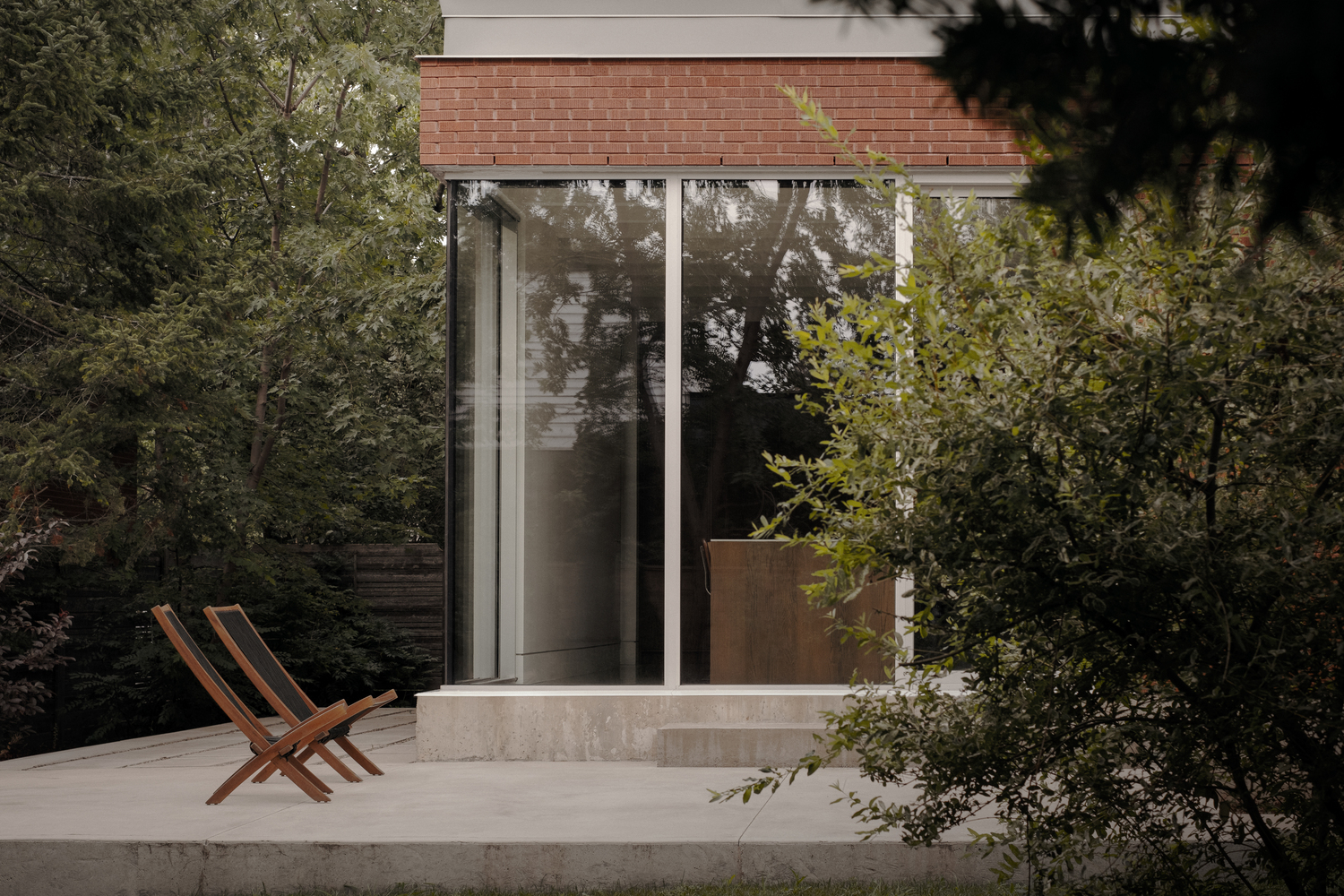Birch Residence
The Birch residence is part of an early 20th-century development in the town of Saint-Lambert, Québec. The original building, with its generous architecture, featured ornamental woodwork and evoked the domestic elegance of the last century. However, the design, with its partitioned rooms, conflicted with contemporary living. The aim was to create fluid, uncluttered spaces that connect to the yard, addressing previous design shortcomings. A compact volume was also built at the rear to house the kitchen.
The new interior layout is organized in two main axes: services and circulation, and living spaces. The kitchen is now the focal point, promoting a natural flow between the ground floor and the exterior. The house’s features are reinterpreted with contemporary touches, such as stained wood veneers, trim work, larger openings, and new views toward the garden. The material palette blends the warmth of wood with the coolness of concrete. A prism of masonry, echoing the original materiality, establishes a formal contrast with the turn-of-the-century building. At once alien and familiar, the extension stands out without confronting.
The house, facing a park and near a school, is close to the historic heart of the village. This area, now a quiet residential neighborhood, is characteristic of the suburban landscape that attracted large numbers of Montrealers, with its picturesque architecture and extensive tree cover. On the outside of the original building, a red combed brick cladding and a traditional roof of galvanized standing seam sheet metal envelop the house, while a wide wooden gallery invites the visitor in. Inside, hardwood floors, trimwork, and ornamental moldings typical of the period transport us to the domestic elegance of the last century.
Without losing the character of this residence, the challenge was to respect the existing structure by emphasizing its qualities, while carrying out well-balanced interventions to adapt the building to today’s wishes and needs. The aim was to offer spaces that were fluid, luminous, uncluttered, spacious, and open to the yard.
The new layout establishes two main axes on the first floor: an axis for services and circulation, and an axis for living spaces. The original entrance door leads into a vestibule, which then opens onto the hall, where historic thresholds have been resized to allow visual continuity towards the verdant courtyard and the new rear access.
Changing the interior composition creates a core around which daily activities revolve. Once isolated, the new kitchen is now the focal point, providing a natural flow and connection between the ground-floor rooms and the outside. Serving as the axis of the kitchen’s organization, the island is both assertive in its monumentality and light in its tectonics.
Respecting the intimate character of the upper floor, interventions here are minimal, including restoring original components such as hardwood floors, moldings, and windows, and reorganizing certain openings to optimize circulation.
In the new annex, the characteristics of the century-old house are reinterpreted in a contemporary way. For example, stained wood veneer and the proportion of the baseboards allude to the historic building. Small paned windows now give way to large corner openings, bathing the interior spaces in natural light and offering framed views of the garden.
Although the site had undeniable landscape qualities, the main floor level of the existing building was high in relation to the natural topography, making it difficult to properly enjoy the garden. The embedding of the extension gradually reconnects the interior spaces with the rear yard. The outdoor terrace acts as a pedestal around which the landscaping is laid.
At once alien and familiar, mysterious and manifest, the extension stands out without confronting. A bold prism of masonry, echoing the original materiality, the new volume establishes a formal contrast with the turn-of-the-century building, soberly crowned with sheet metal coping, reminiscent of the adjacent pitched roof.
The desire for contemporary integration within a historic house is also reflected in the implementation of technical solutions to meet architectural requirements, without compromising occupant comfort and building performance. A more measured approach was recommended for the positioning of openings, and high-performance products, including extra thick triple-glazed units, were selected. A hydronic radiant floor heats the new concrete slab, complemented by a central heating and air-conditioning system powered by a heat pump.
The integration of modern features, including architectural composition, selection of finishes, and formal design, was achieved with full respect for the heritage. This is reflected in the details, volumes, materials, and tactile surfaces that enhance the intrinsic qualities of the residence and its landscape setting. Superfluous clutter and ornamentation were removed while ensuring that the minimalist interiors remain conducive to comfort and gathering.




















